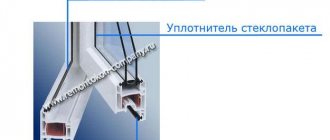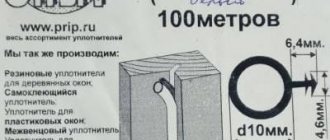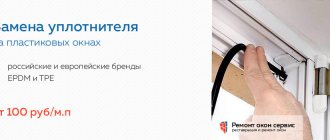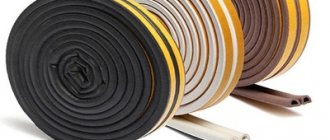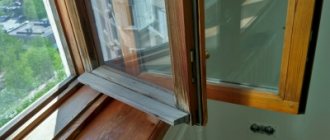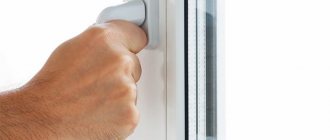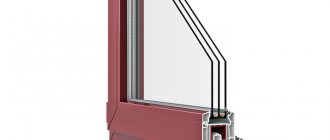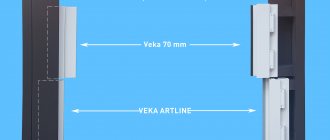Replacement of seals on VEKA windows, we work in Moscow, New Moscow and the entire region. Sealant for plastic windows only from Germany, 100% GOST, certificates of conformity. With high quality, quickly, accurately, we will return warmth and comfort to your home.
The Veko seal is one of the main components of a window or door. Thanks to it, the system does not allow cold, dust, noise into houses and apartments.
Find out prices
Why do you need the VEKA (century) seal in plastic windows and doors?
The VEKA (century) seal is one of the main components of plastic windows and runs along the entire perimeter of the window. To guarantee protection from the influence of the external environment, two sealing circuits are used. One contour is on the frame, the other on the window sash.
Our specialists replace VEKA (century) sealing gaskets on plastic windows. The price for installing and replacing the VEKA seal (veka) is quite affordable.
Our specialists replace VEKA rubber seals on plastic windows. The price for replacing the VEKA (century) rubber seal is quite affordable.
VEKA rubber-rubber epdm seal (veka) is produced by:
— Semperit Germany
— Artie (trademark Elementis) Russia, Tambov
— Union Polimer Tehnologies Russia, Moscow region, pos. Sofrino
— Donskoy Profile LLC, Rostov-on-Don
Selection by form
There are many models of PVC windows made from different types of profiles on the market. The seal is selected individually according to its shape and technical characteristics. There are no universal gaskets. The best option when replacing the rubber seal is to choose products from the same company that manufactured the window profile. However, this is not always possible: there are too many manufacturers.
You shouldn’t be upset: any little-known profile system is similar to the products of a famous brand. This means it belongs to one of three groups:
- Proplex, Novotex, VITRAGE profiles are manufactured according to the KBE standard.
- Rehau analogues: Montblanc, BrusBox and others.
- A large group of domestic profiles are manufactured according to Veka standards.
Exceptions to this rule are rare, so you can select a seal if you know which group the profile belongs to. All components in them are interchangeable.
The shape of the seal also depends on its tasks:
- To seal a double-glazed window, gaskets are placed between the glass and the frame, the glass and the bead.
- To seal the vestibule, sash and frame seals are used.
How to independently determine whether you need to change the VEKA seal (age)
You can determine whether the VEKA (eyelid) seal needs to be replaced on your own. Open the window sash and clean the seal from dirt using a damp cloth. Carefully inspect the seal on the sash and frame. The outer contour usually has more damage. If the seal has become hard, irregularities (tears) have appeared, the color has faded (become uneven) - this plastic window seal must be replaced. Because the outer contour is more susceptible to wear, some window owners, in order to save money, prefer to replace only it, but, in this case, the pressure on the sash is weakened and no one can guarantee that the wind will stop blowing from the window.
Types of VEKA seals (century)
| Marking | Type of seal VEKA (century) |
| seal VEKA (century) 253 | |
| seal VEKA (century) 254 |
Sealant VEKA (century) 253 for frames and sashes
EPDM seals from the well-known manufacturer VEKA (veka) have proven themselves best in operation. The original VEKA (century) seal is marked along its entire length, which indicates its authenticity. The KBE seal is thicker compared to rehau, but this does not mean at all that it will “hold” better. Based on the best intentions, you can install a KBE 228 seal, but the flap may not close!!! Excessive thickness of the seal will interfere. Therefore, based on the size of the groove, the master decides on the spot which seal needs to be installed instead of the worn one.
Sealant VEKA (century) 254 for sashes
Used for a tighter fit of the glass unit to the plastic profile.
Which seal is better, gray or black?
First of all, the quality of the rubber seal depends on the material.
- Gray is the base color of the TPE thermoplastic seal. It can also be white, brown, black. You can order other colors; dyes do not change the properties of the material.
- EPDM and rubber gaskets are black. They contain soot, which plays the role of an antiseptic. These products can also be made gray or colored. But for this purpose, soot is replaced with highly active silicates, which reduce the elasticity of the gum.
Conclusion: a black seal will always have the declared properties, a gray one will be durable only if it is made of TPE. If we are talking about Shlegel Q-Lon PPU tape, then its quality does not depend on color.
From an aesthetic point of view, it is difficult to determine which color of the seal is better, gray, white or black.
- Black emphasizes the outline of the window, but many people don’t like how it stands out against the white plastic.
- The gray and white colors are almost invisible and blend into the frame.
Characteristics of rubber-rubber epdm seals VEKA (century)
| Characteristics | rubber-rubber seal EPDM (EPDM) VEKA (veka) |
| view | |
| Material | ethylene propylene diene rubber |
| color | black |
| Temperature range | -50+100 C |
| Care (maintenance) | Twice a year |
| Service life from the manufacturer | 15 -20 years |
| Service life is real | 10-15 years |
| Average cost of replacing a seal on one sash window (about 8 linear meters required) | from 100 to 250 rubles per linear meter |
| Compliance with GOST 30778-2001 | corresponds |
| Advantages | durable, not afraid of changes and low temperatures, affordable replacement cost |
| Flaws | may stain the frame slightly |
Silicone
The English designation is VMQ. These gaskets have excellent performance properties, but are not popular due to their high cost.
Advantages of silicone seal:
- Elastic, does not deform.
- Does not absorb moisture.
- Does not change its properties and shape in the temperature range from -60 ˚С to +100 ˚С.
- Not afraid of aggressive chemicals.
- Service life - up to 40 years with regular care.
Silicone seals also have a drawback. They do not tolerate mechanical stress well: they are easy to tear or cut.
How to choose a seal for plastic windows?
Seals from different window manufacturers can vary greatly in material, shape, thickness, and elasticity. Therefore, it is better to entrust the diagnosis of the condition of the seal, its selection and replacement to an experienced, qualified technician.
You won’t be able to buy a sealing gasket for plastic windows in a regular construction market. Companies that professionally repair windows buy it in bulk, in rolls of 400-500 meters. Each profile manufacturer has its own seal, because The size of the groove for the seal is different for each manufacturer.
Be careful when choosing a seal for your windows, since in this market, as elsewhere, there are original VEKA sealing gum (veka) and analogues. Analogs are made similar in shape, but the dimensions do not always match. The composition and quality of such seals leave much to be desired. The seal for plastic windows and doors must comply with GOST 30778-2001.
How to change the seal
Replacement is performed in the following order:
- The old gasket is carefully removed, and the seat is cleaned of dirt and residual adhesive solution.
- The sash is removed. To do this, pull out the pin. You can pry it off with a chisel or a thin flat-head screwdriver.
You should not install the seal without removing the sash: it will not be possible to properly secure it in the hinge area.
- Regardless of whether the sealing rubber is attached with glue or simply inserted into the groove, the corners are coated with an adhesive solution.
- The gasket is mounted with a continuous tape: the fewer joints, the better. The cord is laid without tension; it should fit freely in the groove.
- The excess part is trimmed with a painting knife. A joint is made in the corner and secured with glue.
- After the glue has dried, the sash is inserted into place, and a pin is inserted into the hinge.
Signs of correct installation:
- Ease of operation of the sash when opening or closing.
- No blowing.
- The sealing cord remains in the groove after several cycles of operation of the sash.
The new gasket is coated with silicone-based lubricant.
The process is shown in detail and clearly in the video.
GOST 30778-2001 for seals for windows and doors
GOST 30778-2001 defines the scope of application, introduces the classification and designation of seals. Determines technical requirements for the shape and composition of seals. Establishes acceptance rules and methods of control of finished products. Provides instructions for the operation, transportation and storage of seals.
Here are the most interesting excerpts for us:
3 Classification and designations
3.1 Designations of polymer materials used for the manufacture of seals
TPE - thermoplastic elastomer;
EPDM - ethylene propylene diene rubber (terpolymer of ethylene, propylene and diene with the remaining unsaturated part of the diene in the side chain);
ERM - ethylene-propylene rubber (ethylene-propylene copolymer);
VMQ - silicone rubbers containing methyl and vinyl substituted groups;
CR - chloroprene rubber.
3.4 Seals are divided depending on the types of window, door blocks and other structures for sealing the elements of which they are used:
D - for wooden window and door blocks;
P - for polyvinyl chloride window and door blocks;
A - for window and door blocks made of aluminum alloys;
C - for special (other) designs.
8 Operating instructions
8.2 The surfaces of window and door units in contact with the seals must be clean and free of scratches, sharp edges, nicks, scratches and other mechanical damage.
8.3 Installation of seals must be carried out without distortions, twisting and mechanical damage, without jerking or impact.
8.4 To facilitate installation and reduce friction, seals can be treated with a thin layer of silicone grease.
8.5 The seals are installed in the seat without stretching.
How to install or replace the VEKA (century) seal yourself
Is it possible to install or replace the VEKA window seal yourself? Why not. It is not the Gods who burn the pots... As a result of the work, try not to break the hinges and fittings. Everything is simple only in videos on YouTube. And when it comes down to it, a lot of nuances arise that no one will ever talk about anywhere. Our advice is to trust your windows only to experienced craftsmen who every day encounter and successfully solve certain difficulties that arise when replacing seals in plastic windows!
The VEKA (century) seal in the window is needed to prevent moisture from getting inside the profiles and fittings, and to prevent corrosion, for noise and heat insulation, and to avoid dust.
Any rubber product, even with proper care, loses its original performance characteristics over time. The same thing happens with the VEKA (eyelid) sealing gum for windows. Over time, the VEKA (century) window seal seems to “flatten”, cracks and tears appear on it. This means that it ceases to perform its function. The window becomes cold and drafts appear. To restore heat, sound insulation, replacing the VEKA (veka) window seal (replacing VEKA (veka) rubber bands on the windows) becomes simply necessary.
Some craftsmen are trying to solve the problem of “window insulation” on their own. They go to the store and buy self-adhesive insulation. They attach it all over the window and think that the drafts have been defeated!!! However, they do not think at all that this increases the load on the hinges and all fittings, which can lead to serious damage. You absolutely cannot do this!!!
How to determine that the seal needs to be changed?
Signs that the gasket needs to be replaced:
- Change in appearance: the cord has become flattened, covered with cracks, become hard and brittle.
- The appearance of condensation around the perimeter of the glass unit.
- Freezing of the porch in winter.
- Increased street noise level when the window is closed.
- The appearance of a draft when the sash is closed.
- A sheet of paper placed between the sash and the seal can be easily pulled out after closing the window.
Any of these signs indicate that it is time to change the gasket.
Installation and replacement of VEKA seals on windows
In the production of metal-plastic windows, two types of sealing gaskets are used. The shutter (sash) seal VEKA (century) is used on frames and sashes. It protects the profile and fittings from moisture and dust, and the room from all unwanted factors. Another type of sealant VEKA (century) is used for a tighter fit of the glass unit to the frame.
The VEKA seal (eyelid) is most susceptible to adverse environmental influences. Replacing the VEKA seal on the windows will allow you to return warmth and comfort to your home.
You can extend the service life of the VEKA (century) sealing gasket for plastic windows with regular maintenance. It is recommended to clean the VEKA (century) seal in plastic windows once every six months from dirt, wash it with soapy water and lubricate it with silicone grease.
Replacement and installation of VEKA (century) seals in windows takes place on site. In this process, the old seal is removed, the grooves on the sash and frame are cleaned, into which a new VEKA seal is then installed. When replacing the VEKA seal (eyelid) using the pulling method, the window gasket should fit freely into the groove without force or tension.
There are two ways to change the VEKA seal on windows:
- with the removal of the window sash
- without removing the window sash
Based on his experience and the specific situation, the master decides on the spot whether it is necessary to remove the sash to replace the VEKA (century) seal. An experienced plastic window repair technician can efficiently replace the VEKA (century) seal without removing the window sash.
Next fall, your patience has finally run out. They’re not old yet, the plastic windows are blowing again, and the children are constantly getting sick. My hands seem to be growing where they need to be – it looks like it’s time to replace the window rubber! After all, everything looks so simple, and the network is full of descriptions and videos.
But here’s the problem – the master from YouTube easily removes the seal from the frame, but for some reason you just can’t do it. Rubber seems to be soldered into plastic!
After spending some more time searching for an answer, you finally find out - you have a plastic window with a co-extruded seal. Yes, it is a “sealant”, and not rubber - after all, its material is based not on traditional rubber, proven over decades of use of PVC windows, but on plastic modified “towards” greater elasticity. This basically explains the poor “behavior” of your window in winter - the sealing polymer becomes rigid in the cold season and simply stops working fully.
Why is it used at all, you ask? The answer lies on the surface: savings. It is simply cheaper because much less manual labor is used in the window manufacturing process. “Rubber workers” are no longer needed in production, since the seal is part of the plastic profile. The “funny” thing is that this technology is often used by window brands that position themselves as elite and premium!
It is very simple to distinguish the co-extruded “rubber” of a plastic window from the usual one. You need to look carefully at the angle of the window sash. The soldered seal does not “go around” it, like a rubber one, but forms a perfectly right angle, with a clearly visible joint line.
Understanding that such “rubber” is, as a rule, the weakest link in the window, most serious profile manufacturers have provided a hidden technical possibility for replacing it. Under the “plastic rubber band” there is usually a repair groove into which you can install a regular seal for the corresponding profile system. This groove needs to be cleared and prepared accordingly, which will be discussed further.
This article will examine in detail the process of replacing soldered rubber with standard rubber in the well-known VEKA profile. For other profile systems, such as KBE or THYSSEN, there are some differences, mainly in the nuances of removing the old seal.
But the first thing to do for any window is to determine whether such a replacement is possible in principle.
You need to take a thin, sharp object, preferably like an awl (this way, if something happens, there will be less damage), and probe the seal approximately in the middle part. That is, whether it is pierced “in depth” or not, there is a groove inside underneath it, or there is even plastic there.
The check must be done in any case. About a year before this publication, I had the opportunity to repair a huge plastic window in a new building, without a repair groove under the soldered seal - in fact, a one-time window, designed for only a few years of normal operation. The name of his profile is unknown, but this is not so important, since artificially reducing the lifespan of things is a stable global trend. There is absolutely no guarantee that other window brands won't soon follow suit.
Replacing a soldered seal in a plastic window is a more labor-intensive process than replacing regular rubber. It is necessary to remove the sashes from the window, and also the upper hinges from the “pivot” sashes. This is necessary to gain access to the “overlapping” corners of the profile, in which it will be necessary to mill the missing sections of the groove for the seal.
For this work you will need a milling cutter (from a store, or homemade), a drill-driver and a steady, preferably experienced, hand.
The cutter can be made from a 3 mm drill, but if you are not confident in the “hand”, or do not have a similar skill, it is better not to risk it and contact a specialist. Attention!
The description of all the details of how the work of replacing the seal is done in this article is not a call to do it yourself, and I do not bear any responsibility for the window you damage! This is just one of those cases when you should turn to a master, and with the appropriate experience! Our “patient” is the VEKA window, which was installed only 2 years ago. The main reason for replacing the soldered seal is its irreversible deformation as a result of installing curtains (with fastening “hooked” to the edges of the sash), and strong blowing around the perimeter.
With VEKA, the co-extruded rubber does not have to be torn out (like most other profiles, which I will try to talk about later), but cut off. Best of all, a regular knife with replaceable blades is suitable for this.
It turns out something like this:
Excess plastic protruding above the plane in the corners is also cut off.
Next, the “jumpers” between the grooves for the seal are milled.
The result should be like this:
With the sash removed, you can immediately replace the soldered seal with a normal one. The sash “rubbers,” as expected, from the middle of the upper part, the seal is smoothed out as it is tucked into the groove, and neatly placed at the corners.
When working with a regular, “pivot” sash, you have to completely remove the top hinge. Everything else is done exactly the same.
The rubber on the window frame is also changed. In the window in question, the seal on it is normal, but it is installed ugly, in pieces. It is necessary to correct the shortcomings - to mill the remaining jumpers in order to install it “humanly”, in a closed loop. In the same way, this operation is performed if the elastic is soldered into the frame (after it has been removed).
Let me remind you that in VEKA windows there are different types of rubber on the frame and sash, this is very important for the proper operation and tightness of the windows. It is categorically not recommended to install the same, and especially not “native” seal in these windows everywhere, due to their specific design.
The result is obvious. The blowing stopped immediately and completely, and the customer received a full-fledged, repairable window as a bonus!
Useful tips and recommendations for caring for windows and VEKA seals (century)
— if the slightest malfunction occurs in the operation of a plastic window, it is recommended to call a window repair specialist. It is strictly forbidden to use excessive physical force to open (close) a plastic window!
— after repair and restoration work, it is recommended to carry out servicing of the plastic window twice a year (cleaning off dirt and lubricating fittings and seals).
Based on our many years of experience, we recommend to our clients:
- Roto fittings. Due to its quality, Roto fittings have long been well established in the window market. Fine-tuning the window pressure ensures there is no backlash and increases the service life of all mechanisms.
— seals for windows with the highest performance characteristics: REHAU 952 and KBE 228. They comply with GOST 30778-2001 and will last more than 15 years.
Seal care
The average service life of these parts is 10 years. Proper care increases this period by 5–6 years.
The procedure is simple: once every six months, remove dust from the sealing gasket with a damp cloth and treat its surface with silicone-based lubricant. It can be replaced by ordinary glycerin, which is available in any pharmacy. These compounds form an elastic film on the surface of the cord that protects from moisture and sunlight.
Conclusion: the durability of the seal depends not only on the material, but on the quality of installation and care.
An example of an incorrectly selected window seal
The plastic window whistles. What to do?
Let's give a specific example of how the window seal was chosen incorrectly. The owner of an apartment located on Vasilievsky Island (new building, frequent strong winds due to the proximity of the Gulf of Finland) contacted us. The main complaint was that the windows whistle in high winds. Typically, windows whistle when the seal is poorly worn and due to broken internal joint sealing seams.
The owner of the apartment said that some “master” replaced the seal a little over a year ago. Our technician arrived and saw the new seal that was installed there. A little research, and now we see the label from the box of this seal. Please note, this is a groove seal for wooden windows!!! However, the “master” installed it in a plastic window!!! After standing for some time (about a year), this seal became unusable and the windows whistled. Of course, this seal was replaced with the classic rubber-rubber KBE 228, which will last for more than 15 years. Also, our master restored the internal joining seam. The windows stopped whistling, the apartment became warm and quiet.
We repeat once again: Be careful when choosing a seal for your windows! Don't believe the stories about "miracle seals"! There is nothing better than time-tested rubber seals from rehau, kbe and veka.
Frequently asked questions about the VEKA seal (century)
We have collected here the most popular questions about the VEKA (century) seal; we recommend that you read the answers.
Question No. 1
Sealing VEKA (century) for windows
Is it possible to replace the VEKA (century) seal in windows?
Answer:
Yes, it is possible to replace the VEKA (century) seal in windows. Call +7 (812) 904-30-42 and call a specialist to replace VEKA (century) seals in windows in St. Petersburg (St. Petersburg) and the Leningrad Region inexpensively and with high quality.
Question No. 2
How much does it cost to replace a VEKA (century) seal in windows in St. Petersburg (St. Petersburg) and the Leningrad Region?
Maybe it’s easier and cheaper to install a new window than to replace the VEKA (century) seal in the windows?
Answer:
The cost of replacing the VEKA (century) seal in windows starts from 100 rubles per linear meter. Installing a new window is no easier or cheaper than replacing the VEKA (century) seal in the windows.
Question #3
What materials and tools do you use to replace the VEKA (century) seal in windows in St. Petersburg (St. Petersburg) and the Leningrad Region?
Do you have the materials and tools to replace the VEKA (century) seal in my window?
Answer:
In order to replace the VEKA (century) seal in windows, we use only original materials and professional tools. Yes, we have the materials and tools for your window and we can replace the VEKA (century) seal in the window.
Question #4
Do you provide a guarantee for replacing the VEKA (century) seal in a window in St. Petersburg (St. Petersburg)?
What is your guarantee for work on replacing VEKA (century) seals in windows?
Answer:
Yes, we guarantee our work. Work to replace the VEKA (century) seal in windows is guaranteed for one year.
Question #5
Why did it start blowing even more from the windows after replacing the VEKA (veka) seal?
After replacing the VEKA (century) seal, there was even more blowing from the windows, why?
Answer:
Possible answer options: - crooked hands of the master - the “new” seal was incorrectly selected - the “new” seal was installed incorrectly - the fittings of a plastic window or door were not adjusted - a crooked (low-quality) profile - the seal was incorrectly selected for such a profile - there are not enough clamping locks , lock strikers It is worth entrusting this work to professionals so that
the installation or replacement of VEKA (century) seals in windows is done with high quality and without any “surprises”.
Honest reviews from our clients
The best seal for PVC windows: manufacturer ratings
It is more profitable to seal windows with materials from trusted manufacturers. The ranking of the best companies includes:
- Rehau. This German company not only produces profiles, but also supplies them with a full set of necessary high-quality fittings. The seals are shaped like a double petal. In addition to sealing, they prevent the sash from knocking on the frame when closing.
- Veka. Reliable sealing cords at an attractive price. They are distinguished by the angle of inclination: this makes the gaskets less noticeable. Another advantage is the possibility of installation with a whole tape along the entire contour: blowing through the cracks in the corner joints is eliminated.
- KBE produces seals in a variety of shapes and in all possible materials. Distinctive features are quality and durability.
- Welles products stand out for their protective properties. The gaskets are durable and do not change their characteristics throughout their service life.
- Novotec. A young, less well-known company, but quickly conquering the market.
Some useful tips:
- Cheap products are rarely of high quality: prices for decent seals start at 30 rubles per linear meter.
- The products of European companies are superior in quality and appearance to Chinese manufacturers, but are more expensive.
